I Recently Read About These Amazing Glow In The Dark Creatures In The Newspapers And Thought It Was Worth
I Recently read About these amazing glow in the dark creatures in the newspapers and thought it was worth sharing 1. Saprobe Panellus Stipticus, Fungi:


Found in Asia, Australia, Europe and North America, the bio-luminescence emitted by the Saprobe fungi that grows on decaying wood...
More Posts from The-sleepy-chemist and Others
Mammals both produce milk and have hair. Ergo, a coconut is a mammal.
How Smells Trigger Memories By SciShow
SciShow explains how smells can bring back early memories – even memories that your brain didn’t know you had.
Hosted by: Hank Green




Next week I’ll give a presentation on the Researchers Night at Eötvös Loránd University, Hungary with the title: “Chemistry of light and the light of chemistry”.
During this presentation one of my favorite dyes will be also presented: Nile Red. However, just as usual, the 1000 USD/gram price was a bit over our budget, so I had to make it.
The raw product was contaminated with a few impurities, but a fast purification, by simple filtering the mixture through a short column helped a lot and ended up with a +95% pure product.
At first I concentrated the product from a dilute solution on the column as seen on the first pics. It’s interesting to see, that it has a different fluorescence in solution (faint orange fluorescent) and while it’s absorbed on the solid phase (pink, highly fluorescent).
After all the product was on the solid phase, I added another solvent and washed down the pure, HIGHLY FLUORESCENT product. Everything else, what was mainly products of side reactions, stuck at the top of the column as seen on the second pics and the gifs.
Also here is a video from the whole process in HD: https://youtu.be/W0Lk5jkd_B0
“i should drink more water” i remind myself, halfway through my fifth coffee

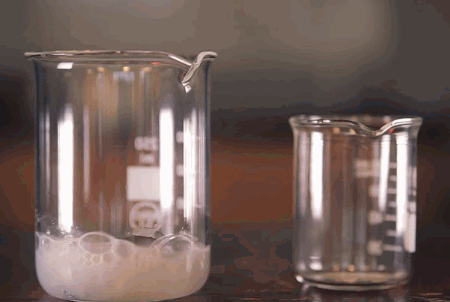
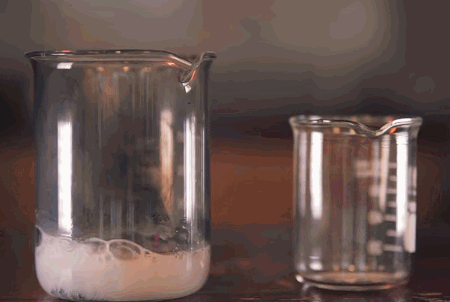
Calcium Carbide: Playing with Acetylene flames
Calcium carbide is a chemical compound with the chemical formula of CaC2. Its main use industrially is in the production of acetylene and calcium cyanamide.
The pure material is colorless, however pieces of technical-grade calcium carbide are grey or brown and consist of about 80–85% of CaC2 (the rest is CaO (calcium oxide), Ca3P2 (calcium phosphide), CaS (calcium sulfide), Ca3N2 (calcium nitride), SiC (silicon carbide), etc.). In the presence of trace moisture, technical-grade calcium carbide emits an unpleasant odor reminiscent of garlic.
Applications of calcium carbide include manufacture of acetylene gas, and for generation of acetylene in carbide lamps, manufacture of chemicals for fertilizer; and in steelmaking.
The reaction of calcium carbide with water, producing acetylene and calcium hydroxide, was discovered by Friedrich Wöhler in 1862.
Reaction with Water:
CaC2+ 2 H2O → C2H2+ Ca(OH)2
possible incomplete combustion occurring:
3C2H2 + 4O2 →2C + 3CO + CO2 + 3H2O
Giffed by: rudescience From: This video
We Are Built To Be Kind
Greed is good. War is inevitable. Cooperation is for suckers.
Whether in political theory or popular culture, human nature is often portrayed as selfish and power hungry. UC Berkeley psychologist Dacher Keltner challenges this notion of human nature and seeks to better understand why we evolved pro-social emotions like empathy, compassion and gratitude.
Subscribe to Fig. 1 on YouTube

Not just one, but seven Earth-size planets that could potentially harbor life have been identified orbiting a tiny star not too far away, offering the first realistic opportunity to search for signs of alien life outside of the solar system.
The planets orbit a dwarf star named Trappist-1, about 40 light years, or some 235 trillion miles, from Earth. That is quite close in cosmic terms, and by happy accident, the orientation of the orbits of the seven planets allows them to be studied in great detail.
One or more of the exoplanets in this new system could be at the right temperature to be awash in oceans of water, astronomers said, based on the distance of the planets from the dwarf star.
“This is the first time so many planets of this kind are found around the same star,” said Michael Gillon, an astronomer at the University of Liege in Belgium and the leader of an international team that has been observing Trappist-1.
Continue Reading.

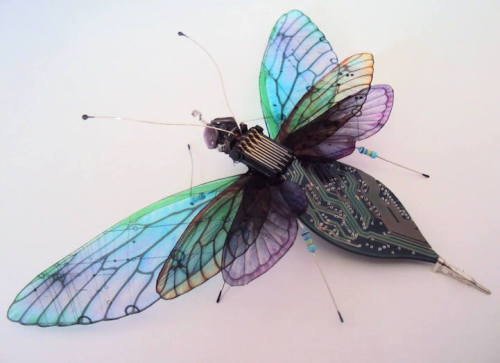
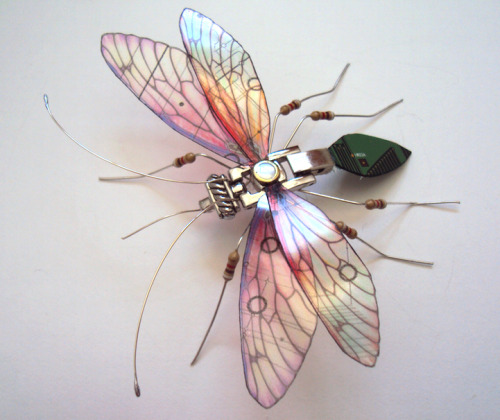

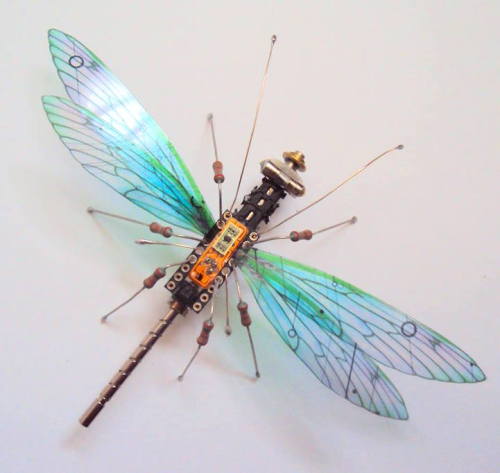
Beautiful Winged Insects Made of Discarded Circuit Boards by Julie Alice Chappell
Successful people dare to fail but refuse to be defeated by failure
(via aslam1)



Imperial Tortoise Beetle - Stolas imperialis
With only 6-12 mm in length, the Imperial Tortoise Beetle, Stolas imperialis (Coleoptera - Chrysomelidae), is truly astonishing by the intense blue color of its body and its elytral punctuation. This species, which is one of 181 that are grouped in the genus Stolas, is poorly known and only registered from Brazil.
References: [1] - [2] - [3]
Photo credit: ©Sergio Monteiro | Locality: Santa Catarina, Brazil (2014)
-
 extraordinarybrai liked this · 1 year ago
extraordinarybrai liked this · 1 year ago -
 moved-to-lunarainstorm-blog reblogged this · 6 years ago
moved-to-lunarainstorm-blog reblogged this · 6 years ago -
 aeshnacyanea2000 reblogged this · 6 years ago
aeshnacyanea2000 reblogged this · 6 years ago -
 catecholamines liked this · 6 years ago
catecholamines liked this · 6 years ago -
 kittiekantha liked this · 6 years ago
kittiekantha liked this · 6 years ago -
 demonicdeviation liked this · 6 years ago
demonicdeviation liked this · 6 years ago -
 pinneapplecrown liked this · 6 years ago
pinneapplecrown liked this · 6 years ago -
 ragirl243 liked this · 7 years ago
ragirl243 liked this · 7 years ago -
 despiteherself reblogged this · 7 years ago
despiteherself reblogged this · 7 years ago -
 textsfromgravityfallsblog liked this · 7 years ago
textsfromgravityfallsblog liked this · 7 years ago -
 zaboomafoo2silly liked this · 7 years ago
zaboomafoo2silly liked this · 7 years ago -
 killershrimp0 liked this · 7 years ago
killershrimp0 liked this · 7 years ago -
 chaointe liked this · 7 years ago
chaointe liked this · 7 years ago -
 tranquility-base-hotel-casino reblogged this · 7 years ago
tranquility-base-hotel-casino reblogged this · 7 years ago -
 theriversdaughter reblogged this · 7 years ago
theriversdaughter reblogged this · 7 years ago -
 borderlinehappy123-blog liked this · 7 years ago
borderlinehappy123-blog liked this · 7 years ago -
 pixelbypixelfanfic liked this · 7 years ago
pixelbypixelfanfic liked this · 7 years ago -
 aeshnacyanea2000 reblogged this · 7 years ago
aeshnacyanea2000 reblogged this · 7 years ago -
 godzillasflyingpizza reblogged this · 7 years ago
godzillasflyingpizza reblogged this · 7 years ago -
 godzillasflyingpizza liked this · 7 years ago
godzillasflyingpizza liked this · 7 years ago -
 sprucesap reblogged this · 7 years ago
sprucesap reblogged this · 7 years ago -
 sprucesap liked this · 7 years ago
sprucesap liked this · 7 years ago -
 minuscodeflower liked this · 7 years ago
minuscodeflower liked this · 7 years ago -
 justancoffeeaddict liked this · 7 years ago
justancoffeeaddict liked this · 7 years ago -
 raelish644 liked this · 7 years ago
raelish644 liked this · 7 years ago -
 lynnie51 liked this · 7 years ago
lynnie51 liked this · 7 years ago -
 farmageddonlove reblogged this · 7 years ago
farmageddonlove reblogged this · 7 years ago -
 blackmoonhunter reblogged this · 7 years ago
blackmoonhunter reblogged this · 7 years ago -
 isabellnecessarythough liked this · 7 years ago
isabellnecessarythough liked this · 7 years ago -
 eleonoraalva reblogged this · 7 years ago
eleonoraalva reblogged this · 7 years ago -
 eleonoraalva liked this · 7 years ago
eleonoraalva liked this · 7 years ago -
 eau-duresistance liked this · 7 years ago
eau-duresistance liked this · 7 years ago -
 acepalindrome reblogged this · 7 years ago
acepalindrome reblogged this · 7 years ago -
 minshibe liked this · 7 years ago
minshibe liked this · 7 years ago -
 recollect-reality reblogged this · 7 years ago
recollect-reality reblogged this · 7 years ago -
 recollect-reality liked this · 7 years ago
recollect-reality liked this · 7 years ago -
 vargaamor liked this · 7 years ago
vargaamor liked this · 7 years ago -
 skumps-skumps-skumpsss reblogged this · 7 years ago
skumps-skumps-skumpsss reblogged this · 7 years ago -
 cryptic-eccentric liked this · 7 years ago
cryptic-eccentric liked this · 7 years ago -
 sterlcat liked this · 7 years ago
sterlcat liked this · 7 years ago -
 bulkycamera reblogged this · 7 years ago
bulkycamera reblogged this · 7 years ago -
 bulkycamera liked this · 7 years ago
bulkycamera liked this · 7 years ago
60 posts